Intel X58 Motherboard Roundup - What does $300 Get You?
by Gary Key on December 5, 2008 3:00 PM EST- Posted in
- Motherboards
SATA Performance
PCMark Vantage is the latest benchmark available from Futuremark, and it is only for use with Windows Vista. Similar to the venerable PCMark05 in its makeup, Vantage modernizes the criteria and test methodology to reflect what users may encounter when running the new Windows OS and current applications. The total HDD benchmark is roughly 87% reads and 13% writes in nature. We run each test five times per drive, producing a median score that we use for comparison in our charts. We utilize AHCI settings for each board.
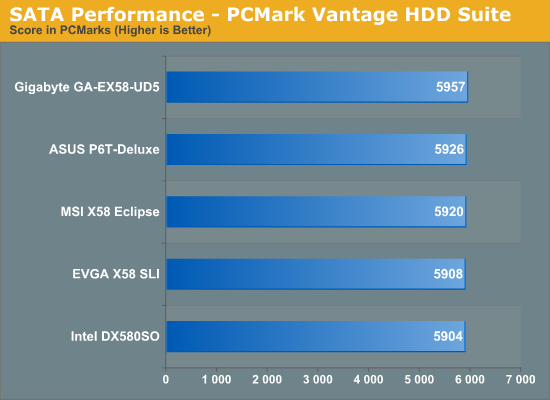

All of the boards utilize the ICH10R for primary storage duties, so there is little difference between the results. In our secondary controller results, we see the SAS solution from Marvell leading the JMicron controllers utilized on the other boards. The MSI and Gigabyte boards both utilize the JMB322 chipset, but we see the MSI board performing better since the JMB322 resides directly on the PCIe bus instead of utilizing the JMB363 as a pass through chip in the same manner that Gigabyte does. EVGA uses the JMB363 chipset and it just barely slides past the Gigabyte setup.
USB / FireWire Performance
Our USB transfer speed tests are conducted with an OCZ Rally 2 Turbo 4GB Flash Drive and USB 2.0/FireWire based Maxtor OneTouch II external hard drive. In the small file test, we transfer a 602MB file folder containing 444 files of various sizes from our hard drive to the USB Flash drive. In the large file test, we transfer a 1.90GB file folder containing 17 different files from our hard drive to the external drive utilizing the USB 2.0 and IEEE 1394a interface.
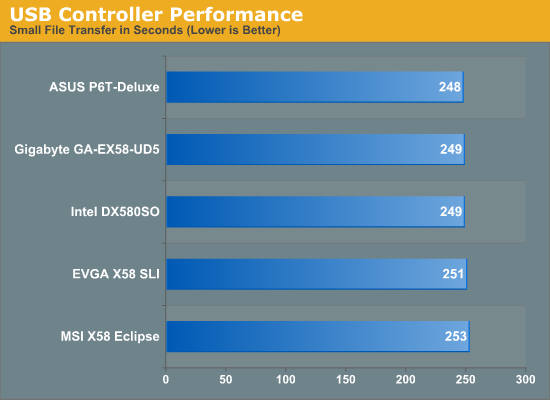
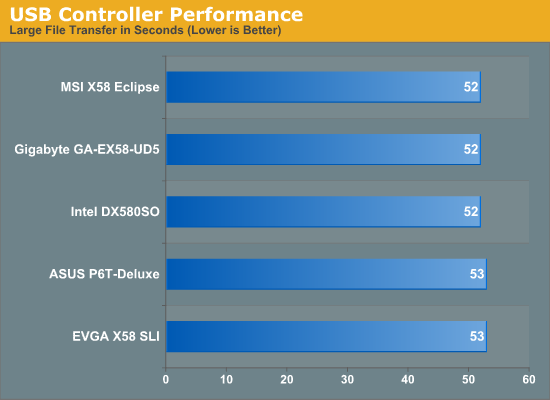
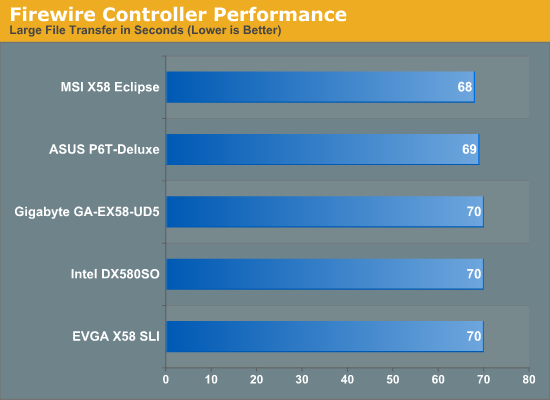
USB performance should be a wash since all the boards use the same ICH10R chipset that provides the USB capabilities. While our synthetic HD Tune tests indicate parity between the boards, the actual transfer of files in the small file test indicates a slight advantage to the ASUS, Gigabyte, and Intel implementations. Our large file USB test is basically a wash as the external hard drive becomes the limiting factor. The VIA FireWire solution on the MSI and ASUS boards hold a small advantage over the Texas Instruments chipset on the other boards.
Networking
The Windows 2000 Driver Development Kit (DDK) includes a useful LAN testing utility called NTttcp. We used the NTttcp tool to test Ethernet throughput and the CPU utilization of the various Ethernet Controllers used on the Intel motherboards. We set up one machine as the server; in this test, an Intel system with an Intel CSA Gigabit LAN connection. Intel CSA has a reputation for providing fast throughput and is a logical choice for our Gigabit LAN server.
On the server side, we used the following Command Line as suggested by the VIA whitepaper on LAN testing:
Ntttcpr -m 4,0,‹server IP› -a 4 -l 256000 -n 30000
On the client side (the motherboard under test), we used the following Command Line:
Ntttcps -m 4,0,‹client IP› -a 4 -l 256000 -n 30000
At the conclusion of the test, we captured the throughput and CPU utilization figures from the client screen.
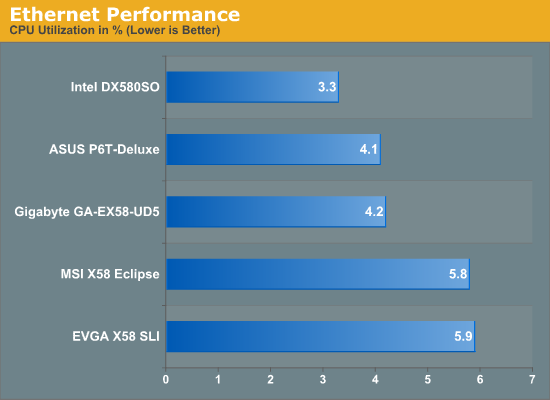
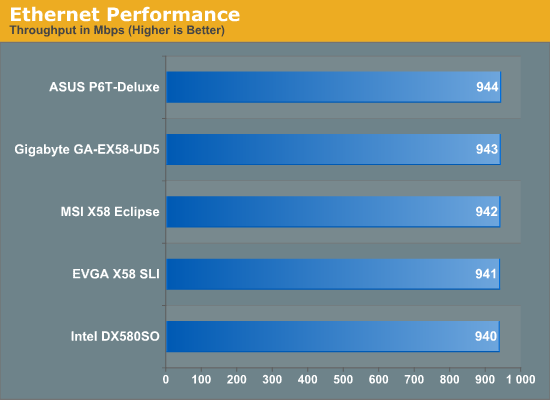
Our network throughput test indicates how well a particular controller design from Realtek, Marvell, or Intel performs instead of being indicative of true chipset performance. This also holds true for the CPU utilization results, though this test can also be influenced to certain degree by the BIOS code and chipset interconnect design.
The CPU utilization numbers favor the integrated GbE controller on the Intel board, followed closely by the Marvell chipset on the ASUS board. The EVGA, MSI, and Gigabyte boards use similar Realtek networking chips, but the Gigabyte board uses the newer RTL8111D over the MSI/EVGA RTL8111Cs. All of the boards feature excellent throughput, with the Marvell solution edging slightly ahead of the Realtek and Intel solutions.










78 Comments
View All Comments
whb456 - Monday, April 20, 2009 - link
They should be paying you for all the hard work you're doing for them. ;-)rreuscher - Thursday, February 19, 2009 - link
Hi,I don't know if this the right place to post this comment, but I try it.
I read that you always perform DPC latency tests in all your reviews, I'm missing this results for this Gigabyte X58-UD5 board.
I build last week a system with an i7/920 CPU (Bios F4) but the DPC latency is a nightmare (my dual core 4 year old laptop outperforms this system). I'm using/intended this machine for dedicated Real Time Audio production, which means I need a steady DPC latency.
The system shows very low DPC latency values with WIN XP and hyperthreading off (about 4 us), but with constantly spikes reaching up to 8000 us, and this is a killer.
Did you did some testing on this also ?
Kind regards, Rene Reuscher
sahina - Tuesday, January 27, 2009 - link
I am looking for 4GB memory sticks for this board but the only one in QVL is S10C1 4GB Samsung M378B5273BH1-CF8 DS Samsung K4B2G0846B HCF8. This is DDR3 1066. I can not find it for sale in the market.Has anyone tested this board with 24GB RAM?
Twoboxer - Monday, January 26, 2009 - link
Anand, your comments represent a start, but . . .If you are not part of the solution, you are part of the problem. Unfortunately, there is very little grey area between "reviewer" and "shill".
1) Ask mfgs to submit samples by Date X.
2) Test until the board will go no further.*
3) Publish report.
4) Rinse and repeat to recognize and publicize improvements, if any.
* If you want to make ONE phone call to each manufacturer, fine.
Allowing mfgs to cherry-pick parts is concession/advantage enough. ONE phone call is honorable. More than that is a disservice to your readers, and denies you your supposed purpose as a reviewer. The time saved during your first review will more than cover rinse/repeat.
In practice I can often get a better idea of what parts to buy after reading a couple of dozen consumer in-use reviews on, for example, Newegg.
You may find it painful or difficult to change course, but you are now at least on the right path. IMO, you can either continue on the return path to "reviewer", or watch Newegg become the de facto replacement for much of your work.
aussie greg - Saturday, January 24, 2009 - link
I want to join the chorus of 'cFoo' and probably many others.What you [Anand] have to say about all the 'SNAFU'S' relating to these boards, have been going on with many other boards for years, My Asus P5 would not work until the 3rd bios update and then failed shotly after...by the time it was replaced updates had reached 12...in 10 months! I was without a fully working mobo for 7 months!
It's not good enough, it's actually pathetic dishonest performance by the manufacturers and probably worth investigating by a relevant govt. authority. Anandtech...and others, should bite the bullet and name names, in detail.
Maybe if some of these companies got the kick up the arse [with apologies] they deserve, we consumers would be better off.
Ausssie Greg
Eru The One - Tuesday, January 20, 2009 - link
I have been pouring over reviews for the last three days comparing any x58 motherboard review I can find. I feel i've narrowed my choice down to the Gigabyte Extreme but I have yet to see anyone comparing DFI's new x58 against anything.I think I should wait before I see someone doing this before I make my final choice. Can you guys at AnandTech help me out here?
tyaiyama - Wednesday, December 17, 2008 - link
I am planning to build a system using P6T Deluxe:Pro: ATX form factor not E-ATX(previously?)
PATA is implemented by Marvel 88SE6111
Dual GbE
Triple channel DDR3
True16+2 Phase Power Design
100% High-quality Japan-made Conductive Polymer Capacitors
Con: Max memory 12 GB
3rd PCIe 2.0 x16 (not usable)
SAS Onboard
Some people may say FDD connector is not necessary, but I need it. I use SATA for all drives; thus I actually do not need PATA, but just in case. Triple channel DDR3 4GB module will be available next month. Since i7 is the memory controller at the same time, what maximum size does it support? I know it is at least 128GB. Through BIOS upgrade, can we use 24GB or more memory in P6T?
cFoo - Sunday, December 14, 2008 - link
Anand, I hope one day you will decide to let the cat out of the bag. Post all the problems and the manufacturer's name beside them. I understand that would risk them from giving you exclusive early access to the boards. But we desperate need accountability. You cannot let them stomp all over fair and accurate journalism.Accountability now! I'm sick of spending $300+ dollar and waiting 1-2 months for fixes. If I wanted to do that, I'll rather wait 1-2 months to buy the board for $100 cheaper!
mwm - Friday, December 12, 2008 - link
Thanks, Anand; I really appreciate the valuable info regarding your experience with partially-DOA motherboards. Where else would be get this information? How many hours would it take a builder to run down the problem? We don't have the bench or knowledge resources to do that. So we are just screwed.Keep up the good work. (I'd even like to see a cheat-sheet on exactly what did not work on a board: a little embarrassment and no sale from guys like myself might prompt them to pay more attention.)
Yours,
mwm
woodworker72 - Wednesday, December 10, 2008 - link
What happened to the Rampage II review? I see the detailed review of the P6 from ASUS. There was a review a few weeks ago that lacked details due to legal restrictions, but what about now? Thanks!